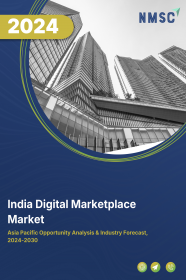
India Digital Marketplace Market by Product/Service Type (Physical Goods, Digital Goods, Services, and Event & Ticket Sales), by Platform (Desktop, Mobile, and Tablets), by Model Type (Business to Business (B2B), Business to Consumer (B2C), and Consumer to Consumer (C2C)), and by End Users (Commercial, and Personal) - Opportunity Analysis and Industry Forecast, 2024 – 2030
Industry: ICT & Media | Publish Date: 08-Sep-2025 | No of Pages: 86 | No. of Tables: 120 | No. of Figures: 65 | Format: PDF | Report Code : IC2251
India Digital Marketplace Market Overview
The India Digital Marketplace Market size was valued at USD 34.11 billion in 2023, and is predicted to reach USD 112.67 billion by 2030, at a CAGR of 18.2% from 2024 to 2030. Digital marketplace market, also referred to as digital commerce platforms or online marketplaces, serve as virtual centers where individuals engage in transactions involving the buying or selling of goods, services, or information. These platforms facilitate exchanges among various parties, including buyers and sellers, within a centralized online environment designed to optimize product discovery, purchasing, and delivery processes. Well-known examples of online marketplaces encompass popular e-commerce platforms such as Amazon, eBay, and Alibaba, alongside service-oriented platforms such as Upwork and Fiverr.
Leveraging sophisticated technology, these platforms streamline transactional procedures, ensuring secure payment processing while enriching user experiences through features such as customer reviews and ratings. Consequently, online marketplaces play an indispensable role in contemporary commerce by bridging the gap between businesses and consumers across diverse geographic locations, thereby facilitating seamless global transactions.
Population Growth Propels India Digital Marketplace Market Expansion
India's expanding population continues to act as a powerful growth driver for the digital marketplace ecosystem. With a demographic profile that includes a large share of digitally engaged youth and a steadily growing working-age segment, the country presents an expansive base of potential users for online platforms. This demographic advantage fuels demand for diverse products and services across both urban and semi-urban areas.
The ongoing digital penetration into Tier II and Tier III cities, driven by rising smartphone usage and affordable internet, is amplifying this growth trajectory. As more consumers come online, digital marketplaces are positioned to serve increasingly broad and varied needs, reinforcing their role as critical commerce facilitators in the Indian economy.
Adoption of Government Initiatives Fuels India Digital Marketplace Market Growth
India’s policy environment is increasingly supportive of digital commerce, with multiple initiatives aimed at formalizing and scaling online retail participation. Programs focused on digital inclusion, financial access, and platform standardization are enabling businesses of all sizes to integrate into the digital economy. These measures are accelerating seller onboarding and improving marketplace transparency.
By creating an open and interoperable digital infrastructure, government-backed frameworks are enhancing competitive parity among sellers and improving accessibility for consumers. These developments are stimulating marketplace expansion, encouraging innovation, and accelerating the adoption of digital commerce across the country.
Cybersecurity and Consumer Trust Acts as Obstacle to India Digital Marketplace Market Expansion
The rising incidence of cyber threats presents a major challenge to the sustained growth of digital marketplaces in India. Issues such as data breaches, online fraud, and misuse of personal information erode consumer trust and create reluctance in sharing sensitive data or completing transactions on digital platforms.
Maintaining consumer confidence is critical for long-term market stability. Ensuring adherence to data protection regulations, improving authentication protocols, and enhancing digital literacy are essential steps toward building a secure and trustworthy digital marketplace ecosystem.
Augmented Reality (AR) and Virtual Reality (VR) Integration Creates Opportunity for India Digital Marketplace Market Expansion
The integration of immersive technologies such as AR and VR is opening new frontiers for digital marketplaces in India. These tools enable more interactive and personalized shopping experiences, allowing users to visualize products in real-world contexts before making a purchase decision. This adds significant value in high-engagement categories and improves overall consumer satisfaction.
As competition among digital platforms intensifies, the use of AR and VR offers a distinct advantage by enhancing user experience and driving engagement. These technologies are expected to play a key role in shaping the next phase of innovation and differentiation within the Indian digital marketplace landscape.
Competitive Landscape
The key players operating in the India digital marketplace industry include Amazon Inc, Flipkart, Meesho, JioMart (Reliance Retail Ventures Ltd.), IndiaMart, snapdeal, Nykaa, FirstCry Marketplace, Tata CLiQ, Pepperfry, Purple, Udaan, DeHaat Marketplace, Limeroad Internet Pvt. Ltd, Cred Store.
India Digital Marketplace Market Key Segments
By Product/Service Type
-
Physical Goods
-
Electronics
-
Clothing
-
Food
-
Furniture
-
Handbag & Accessories
-
Others
-
-
Digital Goods
-
Software
-
E-Books
-
Music & Videos
-
Games
-
-
Services
-
Freelancing
-
Education
-
Consultations
-
Others
-
-
Event & Ticket Sales
By Platform
-
Desktop
-
Mobile
-
Tablets
By Model Type
-
Business To Business (B2b)
-
Business To Consumer (B2c)
-
Consumer-To-Consumer (C2c)
By End User
-
Commercial
-
Personal
Key Players
-
Amazon Inc
-
Flipkart
-
Meesho
-
JioMart (Reliance Retail Ventures Ltd.)
-
IndiaMart
-
snapdeal
-
Nykaa
-
FirstCry Marketplace
-
Tata CLiQ
-
Pepperfry
-
Purple
-
Udaan
-
DeHaat Marketplace
-
Limeroad Internet Pvt. Ltd.
-
Cred Store
REPORT SCOPE AND SEGMENTATION:
|
Parameters |
Details |
|
Market Size in 2023 |
USD 34.11 Billion |
|
Revenue Forecast in 2030 |
USD 112.67 Billion |
|
Growth Rate |
CAGR of 18.2% from 2024 to 2030 |
|
Analysis Period |
2023–2030 |
|
Base Year Considered |
2023 |
|
Forecast Period |
2024–2030 |
|
Market Size Estimation |
Billion (USD) |
|
Growth Factors |
|
|
Companies Profiled |
15 |
|
Market Share |
Available for 10 companies |
|
Customization Scope |
Free customization (equivalent up to 80 working hours of analysts) after purchase. Addition or alteration to country, regional, and segment scope. |
|
Pricing and Purchase Options |
Avail customized purchase options to meet your exact research needs. |

















 Speak to Our Analyst
Speak to Our Analyst
























